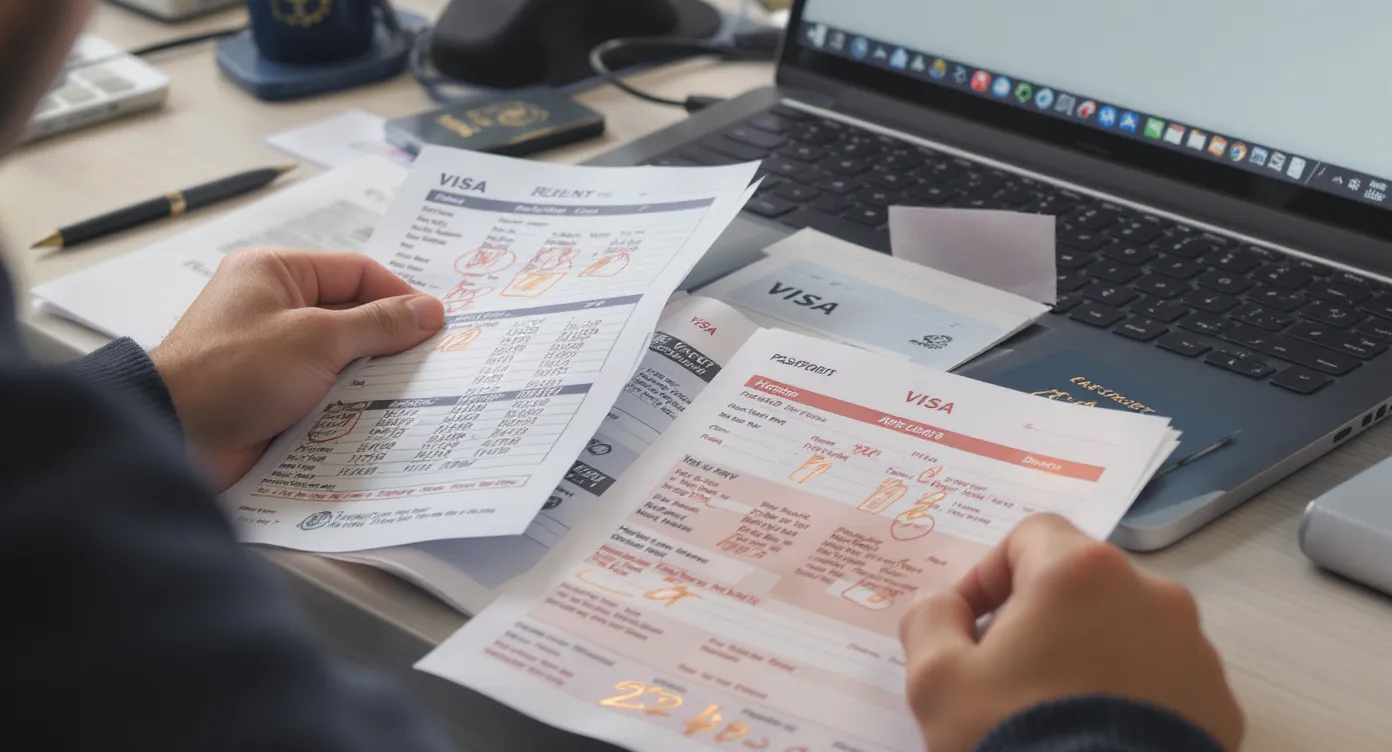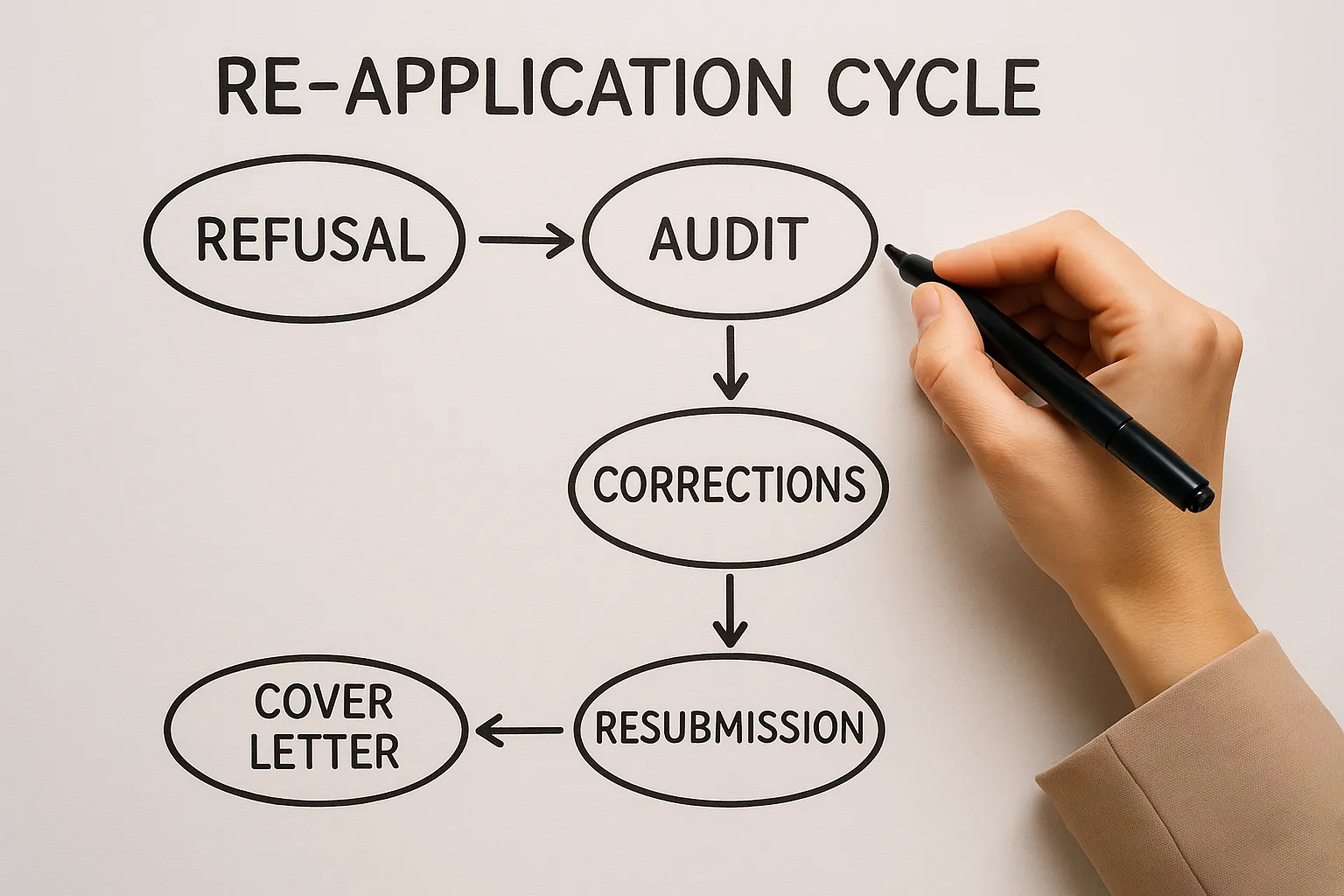Visa Application Denied for Inconsistencies? How to Audit Your Documents Line by Line

Having a visa refused because of “information inconsistency” can feel unfair—especially when the details looked correct at first glance. Yet consular officers reject thousands of applications every day for mismatching dates, names, figures, or supporting documents. According to the U.S. Department of State, over 2 million non-immigrant visa refusals in fiscal year 2024 cited “Section 214(b)” grounds, most of which involved conflicting statements or inadequate proof. The good news? A systematic, line-by-line document audit often turns a denial into an approval on the next attempt.
Why Inconsistencies Trigger Immediate Refusals
Digital visa systems cross-check the data you enter with international watchlists, airline reservation feeds, tax records, and prior application histories. Even small discrepancies—an old employer name in one form field, a mismatched middle initial, or a bank statement that contradicts declared income—raise red flags for automated risk engines and consular staff.
Common inconsistency categories:
| Category | Typical Red Flag | Example |
|---|---|---|
| Identity | Deviating spellings, multiple alphabets | “Mohamed” vs “Muhammad” on passport and bank letter |
| Dates | Overlapping or unrealistic itineraries | Hotel booking 15–20 Nov while flight shows arrival 22 Nov |
| Employment & Income | Job title or salary mismatched across documents | Pay slip lists “Senior Analyst” while application form states “Manager” |
| Travel History | Omitted previous visas or overstays | ESTA record shows prior trip not declared in application |
| Funding | Bank balance insufficient for declared trip cost | $1,200 balance for a three-week Europe itinerary costing $3,000 |
The Pre-Audit: Collect an Exact Copy of Everything You Filed
Before you start correcting errors, assemble a complete replica of your submission:
- PDF or screenshots of each online form page
- Scanned uploads (passport, photos, bank statements, employment letters, marriage certificates, etc.)
- Payment confirmation receipt
- The official refusal letter with reference number and code (e.g., 214(b), 221(g))
If you did not save the forms, many consular portals let you download them after logging back in. Having every single field visible is critical—most inconsistencies hide in plain sight within dropdowns or auto-filled sections.
The Line-by-Line Audit Blueprint
1. Identity Block
-
Compare full name, gender, date of birth, and passport number between:
- Online visa application form
- Passport biodata page
- Airline reservation or e-ticket
- Supporting IDs (national ID, driver’s license)
-
Watch out for transliteration differences. For instance, Russian Cyrillic names often map to multiple Latin spellings. Always mirror the spelling that appears on the machine-readable zone of your passport.
-
Ensure the passport expiration date is correct and provides the minimum validity period required by the destination (often six months beyond intended stay).
2. Travel Plans and Purpose
- Arrival and departure dates must align across tickets, hotel bookings, letters of invitation, and the itinerary section of the form.
- The purpose of travel (tourism, business meetings, study) must be consistent with evidence. A business invitation letter paired with a “tourism” classification invites scrutiny.
- If your plan is flexible, state so—but back it with a route map or statement explaining open-jaw flights.
3. Employment, Education, and Financials
- Match job title, employer name, and start date across the form, the employment verification letter, pay slips, and LinkedIn (yes, officers check public profiles).
- Cross-check salary or income numbers. If your bank statements show lower deposits than your declared salary, explain bonuses or deductions in a cover note.
- For students, make sure the school admission letter details exactly the same program duration you entered.
- For retirees, verify pension statements agree with the income figure in the form.
4. Funding Proof
- Tally the daily budget implied by your itinerary vs. your available bank balance. Many embassies publish minimum funds per day (e.g., France Schengen visa: €120/day without proof of accommodation).
- Ensure account statements cover the required historical window (often three or six months) and that ending balances match totals you declared in any summary box.
- Double-check currency conversions if you converted amounts manually.
5. Travel History and Compliance
- Review the travel history section of the form against actual passport stamps and prior eVisas (ESTA, ETA, ETIAS once live).
- If you previously overstayed or worked illegally, omission usually leads to a ban. Disclose honestly and provide context.
- Confirm that all prior visa denials are declared; many portals ask directly.
6. Supporting Documents Consistency
- Digital photos must meet size, background, and age rules. A new photo with different hairstyle from your passport picture can be flagged as identity mismatch.
- Invitation letters: verify host address, dates, relationship, and signature details. An invitation dated after your flight booking is an obvious mismatch.
- Insurance policies: coverage dates must fully envelop your stay plus any buffer required by destination rules.
7. Final Review and Annotation
Create a two-column spreadsheet:
| Form Field | Document Cross-Check & Notes |
|---|---|
| Surname | Matches passport (yes/no), if not, why? |
| First entry date | Ticket 14 Jan, invitation says 15 Jan. Need new ticket or revised letter. |
| Employer address | Pay slip lists new HQ; visa form shows old branch. Update form. |
Annotate every mismatch and outline the corrective action—new document, explanatory letter, or updated form. Consular officers appreciate concise “fix logs.”

Writing a Clear Consistency Cover Letter
When you resubmit, attach a one-page cover letter (max 300 words) that:
- Acknowledges the previous refusal and reference number.
- Summarizes each corrected inconsistency in bullet form.
- Provides brief context (e.g., “employer rebranded from ACME LLC to ACME Global in March 2025, hence differing pay-slip header”).
- Lists enclosures in the same order the officer will see them.
Keep the tone factual—avoid emotional language or blame. Demonstrating accountability reassures the reviewer.
Leveraging Digital Tools for Accurate Re-Submission
- Document comparison software (DiffPDF, Adobe Compare) spots subtle date typos and duplicate pages.
- Currency-conversion APIs ensure up-to-date financial figures.
- SimpleVisa’s online checklist (see our “Checklist: Everything You Need Before Submitting an Online Visa Application”) automatically flags missing or mismatched fields before you hit submit.
- Store all files in a version-controlled cloud folder so that any future amendments are traceable.
When to Seek Expert Help
Re-applying after one refusal is usually straightforward once inconsistencies are fixed. Consider professional advice if:
- You face tight travel deadlines (less than four weeks).
- The refusal letter cites complex legal grounds (e.g., security or public-charge issues).
- Multiple prior denials indicate systemic problems.
Immigration attorneys or accredited visa agents can draft legal briefs and liaise with consulates—especially for high-stakes business or study cases.
Tips for Travel Businesses and OTAs
If you operate an airline, OTA, or tour company, inconsistent customer visa data leads to booking abandonment and denied boarding fines. Embedding SimpleVisa’s API in your checkout flow allows auto-validation of:
- Passport-name spelling vs. PNR data
- Itinerary dates vs. visa validity windows
- Document completeness (photo EXIF checks, bank statement age)
Our partners report up to 48 % fewer visa-related cancellations after activating pre-submit consistency checks. Explore integration options in our guide “Why Border Crossing Solutions Are the Next Big Ancillary Opportunity.”
Re-Application Timeline and Best Practices
- Wait period: Some embassies enforce a cooling-off period (e.g., 24 hours for India eVisa, 10 days for certain Schengen posts). Verify before resubmitting.
- Refresh documents: Bank statements more than 30 days old can trigger another refusal.
- Book cancellable travel: Until approval, use hold options or fully refundable tickets.
- Track status daily: For portals that allow updates (e.g., Australian ETA), resolve any additional document requests within 48 hours.

Key Takeaways
- Most “inconsistency” denials stem from mismatched data the applicant can correct without legal battles.
- A meticulous, column-based audit of every form field against supporting documents is the fastest route to approval.
- Cover letters that clearly address each fix build confidence with consular officers.
- Digital tools—including SimpleVisa’s automated checklist and API integrations—eliminate manual errors and raise approval rates.
Denied once? Treat the refusal as free feedback, not a final judgment. With disciplined auditing and transparent documentation, your next visa decision is far more likely to read “approved.”